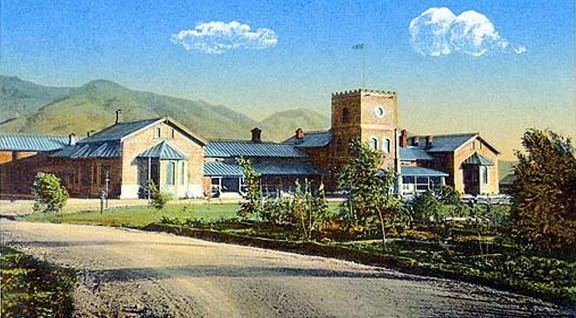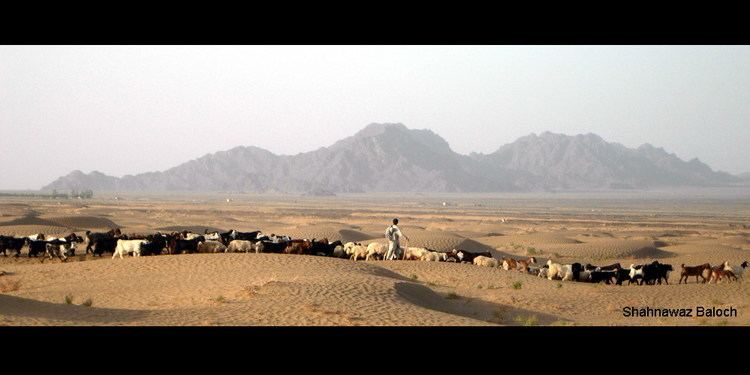Area 347,190 km² | ||
 | ||
Map of Balochistan
Balochistan (Balochi: بلوچستان; also Baluchistan, often interpreted as the Land of the Baloch) is an arid desert and mountainous region in south-western Asia. It comprises the Pakistani province of Balochistan, Iranian province of Sistan and Baluchestan, and the southern areas of Afghanistan including Nimruz, Helmand and Kandahar provinces. Balochistan borders the Pashtunistan region to the north, Sindh and Punjab to the east, and Persian regions to the west. South of its southern coastline, including the Makran Coast, are the Arabian Sea and the Gulf of Oman.
Contents

Etymology

The name Balochistan is generally believed to derive from that of the Baloch people, but this is not certain. The term "Baloch" does not appear in pre-Islamic sources. It is likely that the Balochs were known by some other name at their place of origin and acquired the name "Baloch" after arriving in Balochistan sometime in the 10th century. The Suffix "-stān" is a Persian word meaning "place".

Johan Hansman relates the term "Baloch" to Meluḫḫa, the name by which the Indus Valley Civilisation is believed to have been known to the Sumerians (2900–2350 BC) and Akkadians (2334–2154 BC) in Mesopatamia. Meluḫḫa disappears from the Mesopotamian records at the beginning of the second millennium B.C. However, Hansman states that a trace of it in a modified form, as Baluḫḫu, was retained in the names of products imported by the Assyrians (911–605 BC). Al-Muqaddasī (985 AD), who visited the capital of Makran Bannajbur, states that it was populated by people called Balūṣī (Baluchi), leading Hansman to postulate "Baluch" as a modification of Meluḫḫa and Baluḫḫu.

Asko Parpola relates the name Meluḫḫa to Indo-Aryan words mleccha (Sanskrit) and milakkha/milakkhu (Pali) etc., which do not have an Indo-European etymology even though they were used to refer to non-Aryan people. Taking them to be proto-Dravidian in origin, he interprets the term as meaning either a proper name milu-akam (from which tamilakam was dervied when the Indus people migrated south) or melu-akam, meaning "high country", a possible reference to Balochistan high lands. Historian Romila Thapar also interprets Meluḫḫa as a proto-Dravidian term, possibly mēlukku, and suggests the meaning "western extremity" (of the Dravidian-speaking regions in the Indian subcontinent). A literal translation into Sanskrit, aparānta, was later used to describe the region by the Indo-Aryans.
During the time of Alexander the Great, the Greeks called the land Gedrosia and its people Gedrosoi, terms of unknown origin. Using etymological reasoning, H. W. Bailey reconstructs a possible Iranian name, uadravati, meaning the land of underground channels, which could have been transformed to badlaut in the 9th century and further to balōč in later times. This reasoning remains speculative.
History
The earliest evidence of human occupation in what is now Balochistan is dated to the Paleolithic era, represented by hunting camps and lithic scatters, chipped and flaked stone tools. The earliest settled villages in the region date to the ceramic Neolithic (c. 7000–6000 BCE) and included the site of Mehrgarh in the Kachi Plain. These villages expanded in size during the subsequent Chalcolithic, when interaction was amplified. This involved the movement of finished goods and raw materials, including chank shell, lapis lazuli, turquoise, and ceramics. By 2500 BCE (the Bronze Age), the region now known as Pakistani Balochistan had become part of the Harappan cultural orbit, providing key resources to the expansive settlements of the Indus river basin to the east.
From the 1st century to the 3rd century CE, the region was ruled by the Pāratarājas (lit. "Pārata Kings"), a dynasty of Indo-Scythian or Indo-Parthian kings. The dynasty of the Pāratas is thought to be identical with the Pāradas of the Mahabharata, the Puranas and other vedic and Iranian sources. The Parata kings are essentially known through their coins, which typically exhibit the bust of the ruler (with long hair in a headband) on the obverse, and a swastika within a circular legend on the reverse, written in Brahmi (usually silver coins) or Kharoshthi (copper coins). These coins are mainly found in Loralai in today's western Pakistan.
Herodotus in 450 BCE described the Paraitakenoi as a tribe ruled by Deiokes, a Persian king, in northwestern Persia (History I.101). Arrian describes how Alexander the Great encountered the Pareitakai in Bactria and Sogdiana, and had them conquered by Craterus (Anabasis Alexandrou IV). The Periplus of the Erythraean Sea (1st century CE) describes the territory of the Paradon beyond the Ommanitic region, on the coast of modern Balochistan.
The region was fully Islamized by the 9th century and became part of the territory of the Saffarids of Zaranj, followed by the Ghaznavids, then the Ghorids. Ahmad Shah Durrani made it part of the Afghan Empire in 1749. In 1758 the Khan of Kalat, Mir Noori Naseer Khan Baloch, revolted against Ahmed Shah Durrani, defeated him, and freed Balochistan, winning complete independence.
Governance and political disputes
The Balochistan region is administratively divided among three countries, Pakistan, Afghanistan and Iran. The largest portion in area and population is in Pakistan, whose largest province (in land area) is Balochistan. An estimated 6.9 million of Pakistan's population is Baloch. In Iran there are about two million ethnic Baloch and a majority of the population of the eastern Sistan and Baluchestan Province is of Baloch ethnicity. The Afghan portion of Balochistan includes the Chahar Burjak District of Nimruz Province, and the Registan Desert in southern Helmand and Kandahar provinces. The governors of Nimruz province in Afghanistan belong to the Baloch ethnic group.
In Pakistan, insurgencies by Baloch nationalists in Balochistan province have been fought in 1948, 1958–59, 1962–63 and 1973–77 — with a new ongoing and reportedly stronger, broader insurgency beginning in 2003. Historically, "drivers" of the conflict are reported to include "tribal divisions", the Baloch-Pashtun ethnic divisions, "marginalization by Punjabi interests", and "economic oppression". In Iran, separatist fighting has reportedly not gained as much ground as the conflict in Pakistan, but has grown and become more sectarian since 2012, with the majority-Sunni Baloch showing a greater degree of Salafist and anti-Shia ideology in their fight against the Shia-Islamist Iranian government.
Arts
The Baluchi are a self-sufficient lot, as a whole, and they rely on their own skills to construct their houses and many of the tools necessary in their day-to-day life. Rugs are woven for household use and as items of trade also.
Although the Baluchi are largely an illiterate people and their language was until quite recently unwritten, they have a long tradition of poetic composition, and poets and professional minstrels have been held in high esteem. Their oral literature consists of epic poetry, ballads of war and Romance, religious compositions, and folktales. Much composition is given over to genealogical recitals as well. This poetic creativity traditionally had a practical as well as aesthetic aspect—professional minstrels long held the responsibility of carrying information from one to another of the scattered Baluchi settlements, and during the time of the First Baluchi Confederacy these traveling singers provided an important means by which the individual leaders of each tribe within the confederacy could be linked to the central leadership. The earliest securely dated Baluchi poem still known today dates to the late twelfth century, although the tradition of such compositions is no doubt of much greater antiquity.
Literature
The literature of Baluchi—until quite recently entirely oral and still largely so—consists of a large amount of history and occasional balladry (epic poetry), stories and legends, romantic ballads, and religious and didactic poetry, of which there is an extensive corpus; in addition there is a large variety of domestic verse: work songs, lullabies, and riddles. Possibly the first modest attempt to collect some of this extensive literature is represented by the manuscript BM Cod. Add. 24048 (Elfenbein, 1982). In any case it is quite certain that no systematic attempts were made to collect and reduce to written form any sizeable part of this literature prior to the European (mainly British) interest in it in the 19th century. Of these collections, the earliest of note was made by A. Lewis in 1855; the next important one was by T. J. L. Mayer in 1900. By far the most important and systematic, however, are those by M. Longworth Dames, in 1891, 1907, and 1909. Unfortunately all of these works deal with material which came only from one small area, and in Eastern Hill Baluchi only, thus giving a misleadingly restricted picture of the real extent and variety of this literature, and an inflated estimate of the importance of the dialect in which it was collected. The language of classical Baluchi poetry is traditionally in three dialects (in order of their status and importance): Coastal, Eastern Hill Baluchi, and Kechi.
Music
In ancient times, the Baluchis dwelt in the north and center of . From the 10th century onwards, they slowly moved towards the south until they reached the border of . They now occupy a vast territory covering the western part of , southeastern , and Afghan Khorasan. More recently, they spread along the Arabian coast of the . During this long process of migration, they met other ethnic groups such as the Brahu’is, the Sindis, and the Lasis. Among them were some tribal groups who distinguished themselves by their skill in handicrafts (jewelry and ironwork) and music making. These groups belong to the social category of the osta2 (masters) and mainly to the Rend and Zangeshahi tribes. They may be the descendants of the Luli or Gypsy nomads whose existence is attested to as far back as 2000 years ago.
The outstanding role of these hereditary professional musicians in Baluchi cultural life, brings forth the question of the “purity” concerning the origin of Baluchi music, mainly that of the South (Makran province). It seems at first glance that the old Iranian strata which is attested to by some modes (Qeble, Salat) and rhythms (6/8, 7/8) have been dominated by the Eastern strata which provides the Baluchi music with a specific flavor whose provenance is between Iran‘s maqam and India’s raga. This d the Lasis. Among them were some tribal groups who distinguished themselves by their skill in handicrafts (jewelry and ironwork) and music making. These groups belong to the social category of the osta2 (masters) and mainly to the Rend and Zangeshahi tribes. They may be the descendants of the Luli or Gypsy nomads whose existence is attested to as far back as 2000 years ago.
